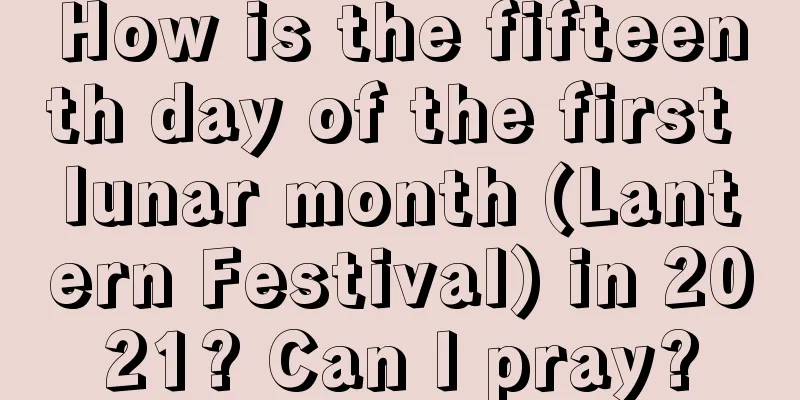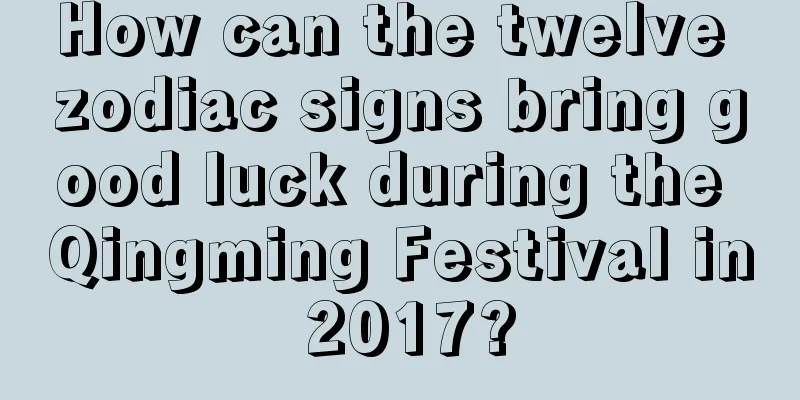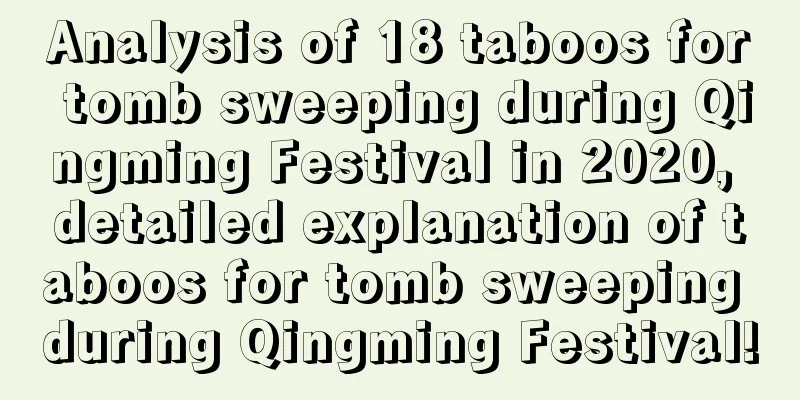Is there a holiday for the Lantern Festival on the 15th day of the first lunar month in 2018? What are the customs of the Lantern Festival?

The Lantern Festival is a traditional festival in my country. There are many customs and habits during the Lantern Festival, and the customs and habits vary depending on the geographical location. Is there a holiday for the Lantern Festival on the 15th day of the first lunar month in 2018? What are the customs of the Lantern Festival? For more details about the 2018 Lunar New Year calendar, please visit the Fortune Teller website for consultation!Is there a holiday for the Lantern Festival on the 15th day of the first lunar month in 2018?No holidays.What date is the fifteenth day of the first lunar month in 2018: Friday, March 2, 2018 (the fifteenth day of the first lunar month in the year of the Dog) Because the Lantern Festival is not one of the legal holidays in our country, although it is an important traditional festival in our country. The Lantern Festival in 2018 is on Friday, March 2nd, so we cannot take a day off. However, some private companies may arrange a half-day holiday at their discretion, so it depends on whether the company usually arranges holidays according to statutory holidays. What are the customs of the Lantern Festival?Eating Yuanxiao is eaten on the fifteenth day of the first lunar month. "Yuanxiao" as a food has a long history in China. In the Song Dynasty, a novel food for the Lantern Festival became popular among the people. This kind of food was first called "Fuyuanzi" and later called "Yuanxiao". Businessmen also called it "Yuanbao". Yuanxiao, also known as "tangyuan", is filled with sugar, rose, sesame, bean paste, osmanthus, walnut kernels, nuts, jujube paste, etc. It is wrapped in glutinous rice flour into a round shape. It can be meat or vegetarian, with different flavors. It can be cooked in soup, fried, or steamed, symbolizing reunion and happiness. The glutinous rice balls in Shaanxi are not wrapped but "rolled" in glutinous rice flour and then boiled or fried. They are hot and round.The fifteenth day of the first lunar month is the Lantern Festival. During this festival, people have the custom of hanging, lighting and watching lanterns, so it is also called the Lantern Festival. Playing with lanterns is a traditional festival custom of the Lantern Festival, which originated in the Western Han Dynasty and flourished in the Sui and Tang Dynasties. After the Sui and Tang Dynasties, the custom of lighting lanterns became popular and was passed down to later generations. The fifteenth day of the first lunar month is the climax of the annual lantern and fireworks festival. That's why the Lantern Festival is also called the "Festival of Lanterns". In Shanxi's county towns and even villages and towns, which are densely populated and prosperous areas, before the arrival of the fifteenth day of the first lunar month, the streets are hung with lanterns, flowers are in bloom and lights are swaying, reaching a climax on the night of the fifteenth day of the first lunar month. The "watching lanterns" on the 15th day of the first lunar month has become a traditional activity for the people of Shanxi Province. Guessing lantern riddles, also known as playing lantern riddles, is a traditional folk cultural and entertainment form unique to China with rich national style. It is a special activity of the Lantern Festival that has been passed down since ancient times. On the fifteenth day of the first lunar month, traditional people would hang up colorful lanterns and set off fireworks. Later, some people wrote riddles on pieces of paper and posted them on colorful lanterns for people to guess. Because riddles can enlighten the wisdom and cater to the festive atmosphere, many people responded to them, and guessing riddles gradually became an indispensable program of the Lantern Festival. Riddles add to the festive atmosphere and showcase the ancient working people’s wisdom and wisdom and their yearning for a better life. [19-20] Dragon dance is also called dragon lantern dance or dragon dance. Its origin can be traced back to ancient times. Legend has it that as early as the Yellow Emperor period, in a large-scale song and dance called "Qingjiao", there appeared an image of a human playing a dragon head with a bird body. Later, a dance scene of six dragons interweaving with each other was choreographed. The first recorded dragon dance was in the "Fu of Western Capital" by Zhang Heng of the Han Dynasty. The author gave a vivid description of the dragon dance in the narration of a hundred plays. According to the "Book of Sui·Music Records", during the reign of Emperor Yang of Sui, the "Yellow Dragon Change" performance, which was similar to the dragon dance in various acrobatics, was also very exciting and dragon dance became popular in many places in China. The Chinese nation worships the dragon and regards it as a symbol of good luck. Stilt walking is a popular mass performance among the people. Stilt walking is a type of acrobatics in ancient China and appeared as early as the Spring and Autumn Period. The earliest introduction of stilts in China is in the Liezi Shuo Fu chapter: "In Song there was a man named Lan Zi, who used his skills to compete with Song Yuan. Song Yuan summoned him and showed him his skills. Lion dance is an excellent Chinese folk art. During the Lantern Festival or gatherings and celebrations, people perform lion dance to add to the fun. This custom originated in the Three Kingdoms period, became popular during the Southern and Northern Dynasties, and has a history of more than a thousand years. [1] "Lion dance" originated in the Wei and Jin Dynasties and flourished in the Tang Dynasty. It is also known as "Lion Dance" and "Taiping Music". It is usually performed by three people. Two of them dress up as lions, one acts as the lion's head, one acts as the lion's body and hind legs, and the other acts as the lion's leader. There are two types of dance: civil and martial. The civil dance shows the lion's tameness, with movements such as shaking hair and rolling. The martial lion dance shows the lion's ferocity, with movements such as leaping, kicking high, and rolling colorful balls. Rowing the land boat Rowing the land boat, according to folklore, is to commemorate Dayu, who made great contributions to flood control. Land boat rowing is also called land boat running, which is to imitate the movement of a boat on land. Most of the people who perform land boat running are girls. The land boat is not a real boat. It is made of two thin boards, sawn into a boat shape, tied with bamboo and wood, and covered with colorful cloth. It is tied around the girl's waist. It is like sitting in a boat. She holds oars in her hands and makes rowing gestures while running, singing local tunes and dancing at the same time. This is land boat rowing. Sometimes there is another man dressed as a passenger on the boat, and his partner in the performance is mostly dressed as a clown, using all kinds of funny actions to amuse the audience. Land boat rowing is popular in many areas of China. |
Recommend
Is it a good idea to get engaged during the Great Cold of 2018? The origin of the engagement?
Introduction: Engagement is a major event in life,...
Is April 18th, a leap month in 2020, an auspicious day for funerals? Is June 9th a good day?
Introduction: Funeral is a serious matter, so an a...
Is November 24th of the lunar calendar in 2021 an auspicious day? Can I get a haircut?
The eleventh month of the lunar calendar belongs t...
Can’t the funeral be held on December 21st of the lunar calendar in 2017?
Introduction: The passing of a person is irreversi...
What does tinnitus in the left and right ears at different times indicate?
What does tinnitus in the left and right ears at d...
Is it a good idea to travel on June 1, 2020, Children's Day? How many days will the Children's Day holiday be in 2020?
Introduction: It is necessary to choose an auspici...
Is it possible to get married or engaged on November 26th of the lunar calendar in 2018?
In the eleventh month of the lunar calendar, the ...
Is it not appropriate to decorate the house on Qingming Festival on March 12, 2020? How should we dress on Qingming Festival?
Introduction: Generally, you need to choose an aus...
Is June 22, 2022, a lucky day or an unlucky day?
The good and bad days in the lunar calendar are di...
What are the do's and don'ts in the lunar calendar for the eighth day of the third lunar month in 2022? Is it possible to have a caesarean section?
March in the lunar calendar is the third month of ...
Is it good for a girl born on Christmas Day 2018?
It is said that girls have two chances to choose t...
2020 Xiaoman - Horoscope for a baby boy born on April 28th!
Grain Full is the 8th solar term in a year and the...
Is it appropriate to start construction on the 15th day of the third lunar month in 2017?
Introduction: In folk culture, many places will ch...
What is the fate of a rat person born on New Year’s Day? Is New Year’s Day 2019 a good time?
New Year’s Day is here. What is the fate of those ...
What date in 2019 is the Frost Descent solar term? What diseases should we prevent during the Frost Descent?
The 24 solar terms are representative of China'...









